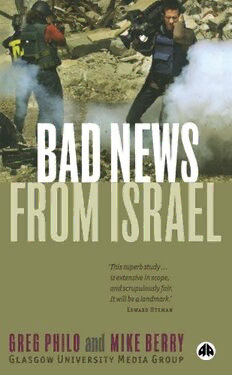
Bad News From Israel PDF
327 Pages·2004·2.943 MB·English
Most books are stored in the elastic cloud where traffic is expensive. For this reason, we have a limit on daily download.
Preview Bad News From Israel
Description:
Based on rigorous research by the world-renowned Glasgow University Media Group, this authoritative and well-referenced book examines media coverage of the current conflict in the Middle East and the impact this coverage has on public opinion. It begins with a history of the present crisis from the period of the British mandate in Palestine through to the creation of Israel, the refugee crisis, the wars, attempts at peace, Oslo and Wye Accords and the intifadas, In the largest study ever undertaken in this area the authors then examine media coverage of the conflict, focusing on television news. They illustrate major differences in the way Israelis and Palestinians are represented, including how casualties are shown and the presentation of the motives and rationales of both sides. This is combined with a very extensive audience study involving hundreds of participants from the USA, Britain and Germany. It shows extraordinary differences in levels of knowledge and understanding, especially amongst young people from these countries. The study also uses new techniques to identify trends in public understanding and belief. Uniquely, it brings together senior journalists and ordinary viewers who work jointly to examine how audiences understand the news and how public belief and opinion have been shaped by media reporting. The book includes sections on theory and methods and shows the processes which shape the news. It looks at patterns of ownership and at how public relations, information control and the close political links between the USA and Britain affect what we see and hear in the media.
See more
The list of books you might like
Most books are stored in the elastic cloud where traffic is expensive. For this reason, we have a limit on daily download.
